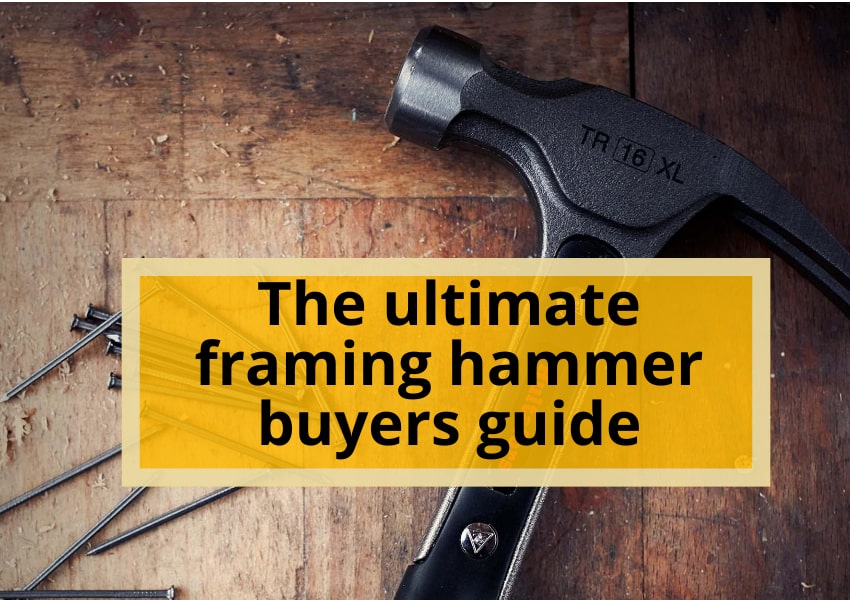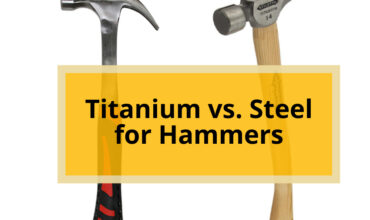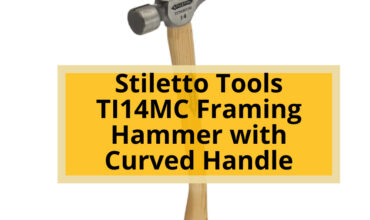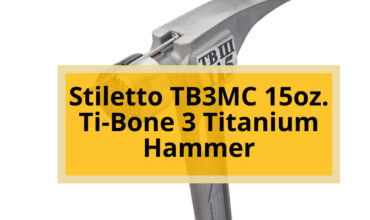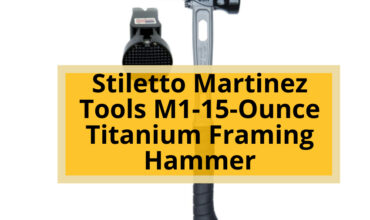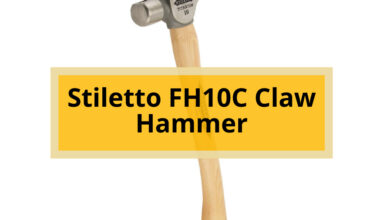This comprehensive guide is your ticket to finding the perfect framing hammer. With expert recommendations, detailed comparisons, and valuable insights, you’ll be equipped with the knowledge to make an informed choice.
Say goodbye to flimsy hammers and hello to power and precision. It’s time to belong to the world of skilled craftsmen and build with confidence.
What To Consider When Buying the Best Framing Hammer
When selecting the best framing hammer, there are several key factors to consider.
- Head Material
- Head Weight
- Handle Length
- Handle Material
- Grip Type and Style
- Face Type and Size
- Claw Type
- Tang
- Balance
- Magnetic Nail Set
- Shock Absorption
- Hammer’s Total Weight
- Safety Aspects
- Price
- Warranty
- Brand Reputation
Now, let’s delve into the importance of each factor.

1. Head Material
To choose the best framing hammer for your needs, consider the head material. It plays a crucial role in the hammer’s durability and performance. The head material determines the strength and impact resistance of the hammer.
Most framing hammers have heads made of either steel or titanium. Steel heads are known for their strength and durability, making them suitable for heavy-duty tasks. Titanium heads, on the other hand, are lighter and provide better shock absorption. This reduces the strain on your arm during prolonged use.
Both materials have their advantages, and it ultimately depends on your personal preference and the specific tasks you’ll be using the hammer for. Consider the type of projects you’ll be working on, and choose a framing hammer with a head material that suits your needs.
2. Head Weight
Consider the weight of the head when choosing a framing hammer, as it directly impacts the power and effectiveness of your swings. The head weight of a framing hammer is crucial in determining how much force it can generate when striking nails or other materials.
A heavier head will deliver more power, allowing for faster and more efficient driving of nails. However, it is important to find a balance between power and control. A framing hammer that is too heavy may be difficult to handle, leading to fatigue and less precise swings.
On the other hand, a hammer that is too light may not provide enough force to properly drive nails into tough materials. It is recommended to choose a framing hammer with a head weight that suits your strength and the demands of your projects.
3. Handle Length
You should choose a framing hammer with a handle length that feels comfortable and provides you with the leverage and control you need for your projects.
The handle length plays a crucial role in determining the overall balance and maneuverability of the hammer. A longer handle can provide greater leverage, allowing you to generate more force with each swing. However, it can also make the hammer feel heavier and more difficult to control.
On the other hand, a shorter handle may offer more control but could limit your ability to generate powerful strikes. It’s important to find the right balance that suits your personal preferences and the requirements of your projects.
Consider testing out different handle lengths to see which one feels most comfortable and allows you to work with ease.
4. Handle Material
The handle material of a framing hammer greatly affects its durability and vibration reduction. When choosing a framing hammer, it is important to consider the handle material as it can determine the overall performance and longevity of the tool.
One popular handle material is fiberglass, which offers excellent durability and vibration reduction. Fiberglass handles are resistant to moisture, chemicals, and extreme temperatures, making them suitable for various work environments.
Another common handle material is steel, known for its strength and durability. Steel handles are less likely to break or crack under heavy use. However, they may transmit more vibrations to the user’s hand.
Wooden handles, on the other hand, provide a traditional and comfortable grip, but may not be as durable as fiberglass or steel.
Ultimately, the choice of handle material depends on personal preference and the specific needs of the user.
5. Grip Type and Style
When selecting a framing hammer, it’s important to choose a grip type that provides comfort and control during use. The grip of a framing hammer plays a crucial role in ensuring that you can handle the tool with ease, reducing the risk of accidents and fatigue. There are several grip types available, each offering different levels of comfort and control.
One common grip type is the shock reduction grip, which is designed to minimize vibration and impact on your hand while using the hammer. This grip absorbs the shock from each strike, reducing the strain on your hand and arm muscles. It provides a cushioned and ergonomic grip that allows for extended use without discomfort.
Another popular grip type is the non-slip grip, which ensures that the hammer stays firmly in your hand, even in wet or sweaty conditions. This grip is usually made of rubber or textured material, providing a secure and reliable hold. It allows for precise control over the hammer, preventing any accidental slips or mishaps.
Lastly, there is the cushion grip, which offers a soft and comfortable handle that reduces hand fatigue during prolonged use. This grip is often made of materials like foam or gel, providing a cushioned surface that absorbs impact and allows for a more relaxed grip. It is particularly beneficial for those who need to use the hammer for extended periods.
The straight handle grip style is a popular choice among professionals and DIYers. It offers a traditional and familiar feel, allowing for a natural hand position and a secure grip. This grip type provides excellent control and precision while driving nails or prying boards.
On the other hand, the curved handle grip styly is designed to reduce hand fatigue and improve overall comfort. The curve in the handle allows for a more ergonomic grip, reducing strain on the wrist and forearm. This type of grip is especially beneficial for those who plan on using the framing hammer for extended periods.
When selecting a framing hammer, consider your personal preferences and the type of work you will be doing. Choose a grip type that suits your needs and provides the comfort and control necessary for your tasks. By selecting the right grip, you can ensure a more enjoyable and efficient hammering experience.
6. Face Type and Size
Consider the face type and size of a framing hammer to ensure optimal strike contact with nails.
The face of a framing hammer refers to the striking surface that comes into direct contact with the nail. It is important to choose a hammer with a face type that matches your specific needs.
The most common face types are smooth face and milled face. A smooth face is ideal for general framing tasks, while a milled face provides better grip and reduced slippage when driving nails into wood.
Additionally, the size of the face should also be taken into consideration. A larger face size offers a larger striking surface, increasing the chances of hitting the nail accurately. On the other hand, a smaller face size allows for more precise strikes in tight spaces.
7. Claw Type
Choosing the right framing hammer involves considering the claw type and its functionality. The claw of a framing hammer is a crucial feature that determines its versatility and effectiveness in different tasks. There are two main types of claw designs: curved and straight.
A curved claw is the most common and traditional type. It is designed for pulling nails and prying boards. The curve allows for a better grip on the nail head, making it easier to extract nails from wood. This claw type is suitable for a wide range of framing and construction tasks.
On the other hand, a straight claw is more specialized and is primarily used for demolition work. It is ideal for ripping apart materials and removing large nails. The straight design allows for better leverage and precision when prying or tearing down structures.
When choosing a framing hammer, consider the type of work you will be doing. If you will be primarily involved in framing and general construction tasks, a curved claw hammer is the most versatile option. However, if you anticipate working on demolition projects, a straight claw hammer would be more suitable.
Ultimately, the choice between a curved claw and a straight claw hammer depends on the specific needs of your projects. Consider the tasks you will be performing and select a framing hammer with a claw type that provides the functionality and versatility required for your work.
8. Tang
The tang of a framing hammer is an important factor to consider when determining its weight and impact vibration. The tang refers to the portion of the hammer that extends into the handle. It plays a crucial role in the overall balance and performance of the tool.
A full tang, where the metal extends the entire length of the handle, provides better weight distribution and reduces vibration during use. This results in a more comfortable and efficient swinging motion, reducing fatigue and increasing productivity.
On the other hand, a partial tang may lead to a heavier head and increased vibration, which can be tiring and less effective.
Therefore, when selecting a framing hammer, it is essential to choose one with a full tang to ensure optimal weight distribution and minimal impact vibration.
9. Balance
Balance refers to the distribution of weight throughout the tool. A well-balanced hammer ensures that the weight is evenly distributed, allowing for better control and reduced strain on your arm.
A hammer that is too heavy on one end will cause you to exert more effort to swing it, leading to fatigue and decreased productivity. On the other hand, a hammer that is too light may not provide enough power for driving nails effectively.
To find the right balance, consider the weight distribution and handle design of the hammer. Look for a hammer with a balanced weight distribution and a comfortable grip to ensure a smooth and accurate swing every time.
10. Magnetic Nail Set
When you’re looking for a framing hammer, you’ll appreciate the convenience of a magnetic nail set. A magnetic nail set is a feature that allows you to easily hold nails in place while you position them for hammering. This feature saves you time and frustration by eliminating the need to hold nails with your fingers or fumble with them while trying to hammer.
With a magnetic nail set, you can simply place the nail on the set and it will stay in place until you’re ready to drive it into the material. This not only improves your efficiency, but also helps you maintain accuracy and precision in your work.
Whether you’re a professional or a DIY enthusiast, a framing hammer with a magnetic nail set is a valuable tool that will make your framing tasks much easier and more enjoyable.
11. Shock Absorption
Now that you have learned about the convenience of a magnetic nail set in framing hammers, let’s move on to another important feature: shock absorption.
When you’re working with a powerful tool like a framing hammer, it’s crucial to consider the impact it can have on your hands and arms. That’s where shock absorption comes into play.
Framing hammers with shock absorption technology are designed to minimize the vibrations caused by each strike. This not only reduces the strain on your body but also improves your overall comfort and control. You’ll be able to work for longer periods without feeling fatigued or experiencing discomfort.
Manufacturers achieve shock absorption by incorporating various materials and designs into the handle of the framing hammer. These features help dampen the vibrations, allowing you to focus on the task at hand without worrying about the impact on your body.
When choosing a framing hammer, look for models that prioritize shock absorption. This feature will greatly enhance your experience and make your framing tasks more enjoyable.
12. Hammer’s Total Weight
To determine which framing hammer is right for you, take into account the total weight of the hammer. The weight of a framing hammer plays a crucial role in its performance and suitability for the job at hand.
A heavier hammer, typically weighing around 22 ounces, provides more power and force when driving nails into wood. This weight allows for efficient and effective framing work.
On the other hand, a lighter hammer may be more suitable for tasks that require more precision and control. It is important to consider your own strength and comfort level when selecting a framing hammer.
13. Safety Aspects
One important aspect to consider is the safety features of framing hammers. When choosing a framing hammer, it is crucial to prioritize your safety. Look for hammers that have features designed to protect you from potential accidents and injuries.
One such feature is a magnetic nail starter, which allows for easier and safer nail insertion. This feature eliminates the need for holding nails with your fingers, reducing the risk of accidental strikes.
Additionally, consider hammers with shock reduction grip technology. These grips help to minimize the impact of vibration, reducing the strain on your hand and arm muscles. This not only enhances comfort but also decreases the likelihood of repetitive strain injuries.
Weight distribution is essential for maintaining balance and control while swinging the hammer. A properly balanced framing hammer will help you strike with precision and reduce the risk of accidents.
14. Price
Consider your budget when choosing a framing hammer, as the price range can vary significantly. Framing hammers are essential tools for building the frame of a structure, and it’s important to find one that suits your needs without breaking the bank.
The good news is that there are options available for every budget. If you’re looking for the best overall value, look for framing hammers manufactured by Estwing or Milwaukee. They offer outstanding performance, durability, and balance at a reasonable price.
For those on a tighter budget, the Tekton 22 Oz. Magnetic-Head Framing Hammer is the best bang for the buck. It provides sufficient power for framing tasks and even includes a magnetic nail set for easier nail insertion.
No matter what your budget is, there is a framing hammer out there that will meet your needs and help you get the job done right.
15. Warranty
When choosing a framing hammer, it’s important to take into account the warranty offered by the manufacturer. A warranty provides you with peace of mind, knowing that your investment is protected.
Look for manufacturers who offer a lifetime warranty, as this demonstrates their confidence in the quality and durability of their product. Some framing hammers may come with a limited warranty, which still offers some level of protection.
Keep in mind that the warranty may have certain limitations or conditions, such as excluding normal wear and tear or misuse. Reading the fine print and understanding what is covered under the warranty is crucial.
16. Brand Reputation
If you’re looking for a reliable framing hammer, you can trust brands with a strong reputation in the industry. These brands have established themselves as leaders in the field and have earned the trust of professionals and DIYers alike.
When it comes to framing hammers, brand reputation is important because it reflects the quality and performance of the product. Brands with a strong reputation have consistently delivered hammers that are durable, efficient, and comfortable to use. They have invested in research and development to create innovative features that enhance the hammer’s performance and make it easier to handle.
Benefits Of Owning a Framing Hammer
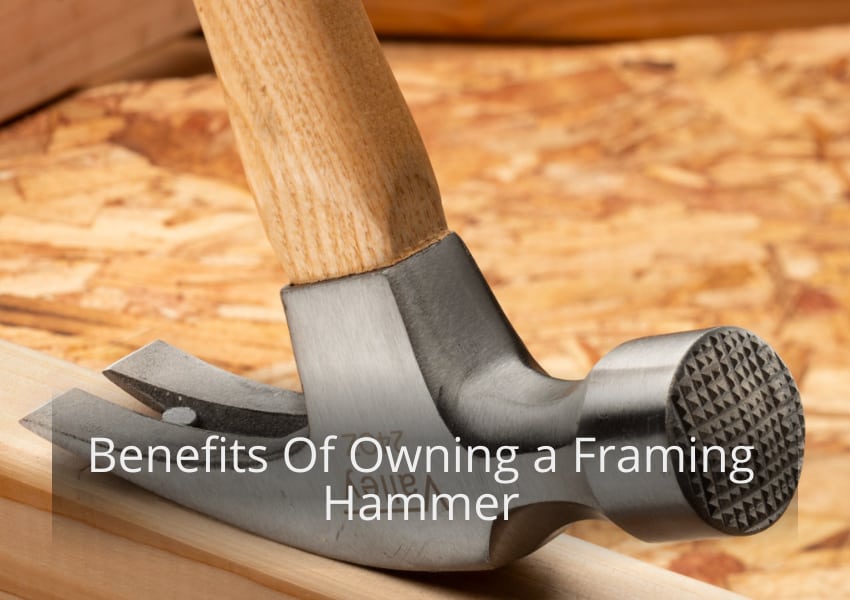
Owning a framing hammer provides you with the ability to efficiently and accurately drive nails into wood during construction projects. This essential tool is designed specifically for building the frame of a structure.
Unlike standard household hammers, framing hammers are heavier and more powerful, allowing you to generate powerful blows. The straight and elongated claw is a key feature of framing hammers, enabling you to pull nails and pry boards with ease.
When choosing a framing hammer, it’s important to consider factors such as head weight, handle material, face type, claw shape, and tang type. By selecting the right framing hammer for your needs, you can ensure that your projects are completed with precision and efficiency, making you an integral part of any construction team.
Weight Of the Hammer VS Your Strength
If you’re not sure which framing hammer to choose, consider the weight of the hammer in relation to your own strength. The weight of the hammer is a crucial factor to consider because it directly impacts your ability to effectively use the tool.
A framing hammer that is too heavy for your strength can lead to fatigue and strain, while a hammer that is too light may lack the necessary power to drive nails into tough materials. Finding the right balance is key.
For individuals with greater strength and experience, a heavier framing hammer around 22 to 28 ounces may be suitable. However, if you are less experienced or have limited strength, a lighter hammer around 16 to 20 ounces may be more manageable.
Ultimately, choosing a framing hammer that matches your strength will allow you to work efficiently and safely.
Arithmetically, What Creates the Strength of Each Strike?
The strength of each strike is created arithmetically based on the weight and force applied with the framing hammer. When you swing the hammer, the weight of the head determines the impact it will have on the nail or material you are working with. The heavier the head, the more force it will generate upon impact.
This force, combined with the velocity of your swing, determines the strength of each strike. It is important to use proper technique and apply enough force to ensure a solid connection between the hammer and the nail. With practice and experience, you will develop a sense of how much force is needed to drive the nail effectively without causing damage.
Remember to always use caution and wear appropriate safety gear when using a framing hammer.
How To Test a Framing Hammer?
One way to test a framing hammer is by examining its shock absorption capabilities. This is an important factor to consider because it directly affects your comfort and safety while using the hammer.
When testing the shock absorption of a framing hammer, you can start by striking different surfaces with the hammer and paying attention to the vibrations you feel in your hand and arm. A good framing hammer should have a handle that absorbs and dampens the vibrations, reducing the impact on your body.
Additionally, you can also test the grip of the hammer by holding it firmly and swinging it with force. A comfortable and secure grip will ensure that you have full control over the hammer and can deliver powerful strikes with accuracy.
How To Maintain a Framing Hammer?
Now that you understand the benefits of owning a framing hammer, let’s delve into how to maintain this essential tool.
Proper maintenance can prolong the lifespan of your framing hammer and ensure its optimal performance.
First and foremost, it’s important to clean your framing hammer regularly. After each use, remove any debris, such as wood chips or nails, from the head and claws. Wipe the entire hammer with a clean cloth to prevent rust and corrosion.
Next, inspect the handle for any signs of wear or damage. If you notice cracks or splintering, it’s best to replace the handle to ensure your safety.
Additionally, it’s crucial to keep the head of your framing hammer sharp and in good condition. Using a file or a sharpening stone, carefully sharpen the edges of the claws to maintain their effectiveness in pulling nails.
Lastly, store your framing hammer in a dry place to prevent moisture from causing rust. Consider using a tool rack or a designated toolbox to keep it organized and protected.
How To Store a Framing Hammer?
When storing a framing hammer, it’s important to keep it in a dry place to prevent rust and corrosion. Moisture can cause damage to the metal surface of the hammer, leading to rust formation and decreased performance.
To ensure the longevity of your framing hammer, find a storage location that is free from moisture, such as a tool cabinet or a designated toolbox. It’s also a good idea to clean the hammer before storing it to remove any dirt or debris that may have accumulated during use. Simply wipe it down with a clean cloth and ensure that it is completely dry before putting it away.
Frequently Asked Questions
What Is the Average Lifespan of a Framing Hammer?
The average lifespan of a framing hammer depends on several factors, such as frequency of use, maintenance, and quality of construction. With proper care, a framing hammer can last for many years of reliable service.
Can A Framing Hammer Be Used for Tasks Other Than Framing?
Yes, a framing hammer can be used for tasks other than framing. Its weight and power make it suitable for various construction tasks like driving large nails, demolition work, and even some woodworking projects.
Are There Any Safety Precautions to Take When Using a Framing Hammer?
When using a framing hammer, it’s crucial to prioritize safety. Always wear protective gear like goggles and gloves. Ensure a secure grip on the handle and maintain proper body posture to prevent injury.
Can A Framing Hammer Be Repaired If It Gets Damaged?
Yes, a framing hammer can be repaired if it gets damaged. Depending on the extent of the damage, you may need to replace the handle or head. It’s best to consult a professional for repairs.
How Do I Choose the Right Size Framing Hammer for My Needs?
To choose the right size framing hammer for your needs, consider the weight of the hammer head and the length of the handle. A good rule of thumb is to match the hammer weight to your arm strength and the type of framing work you’ll be doing.
Conclusion
In conclusion, choosing the right framing hammer is crucial for any construction project. By considering factors such as head weight, handle material, and claw shape, you can ensure that you have a powerful and reliable tool at your disposal.
Remember to test the hammer before purchasing, and maintain it properly to prolong its lifespan. Lastly, always store your framing hammer in a safe and secure location.
As the saying goes, ‘A good hammer is worth its weight in gold.’ So invest wisely and enjoy the benefits of owning a high-quality framing hammer.
